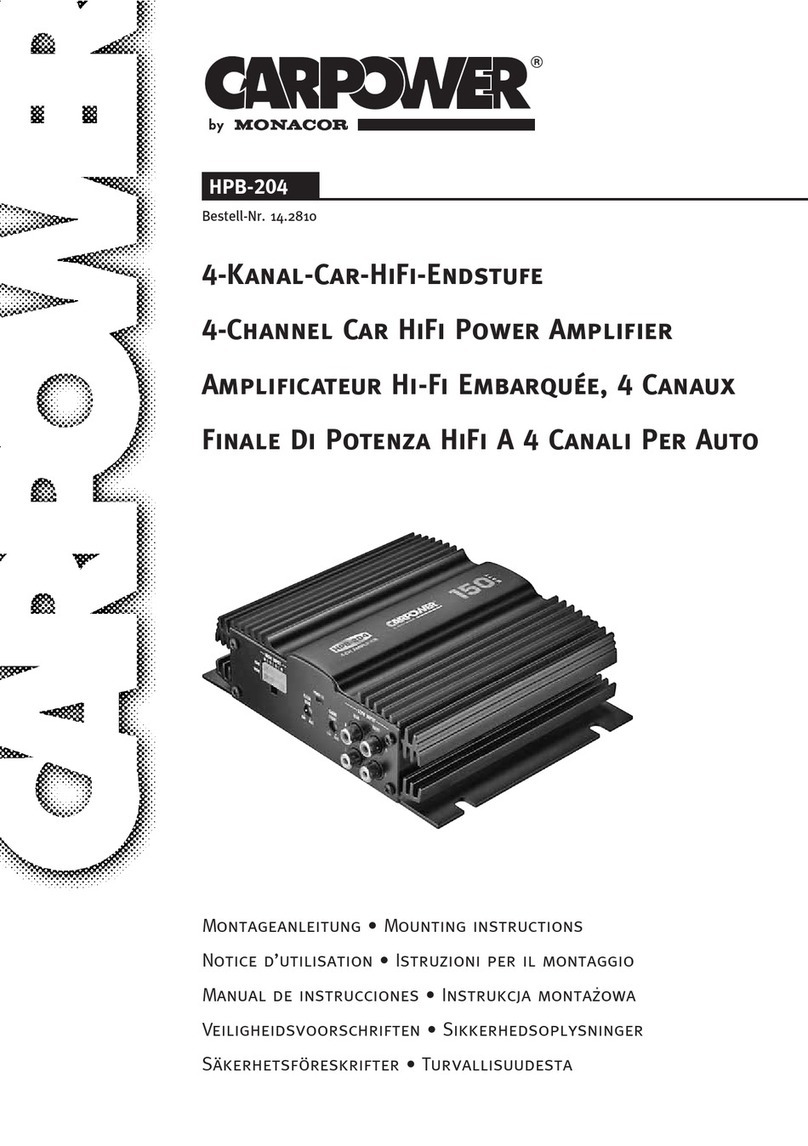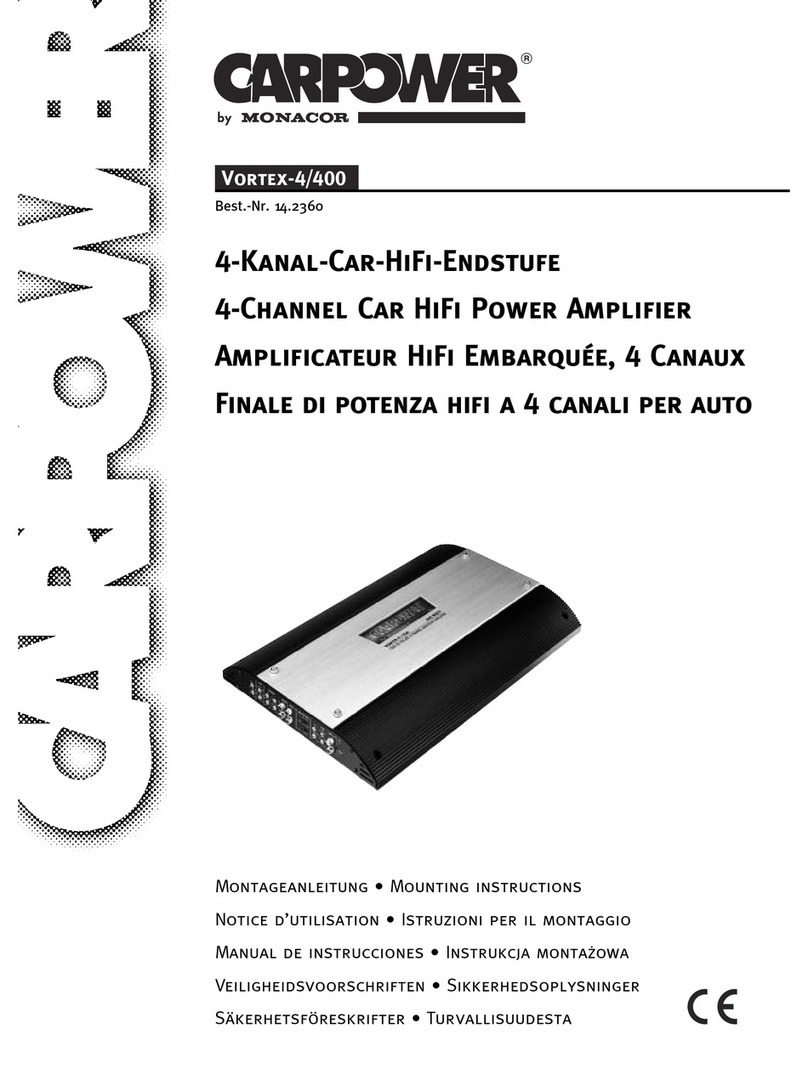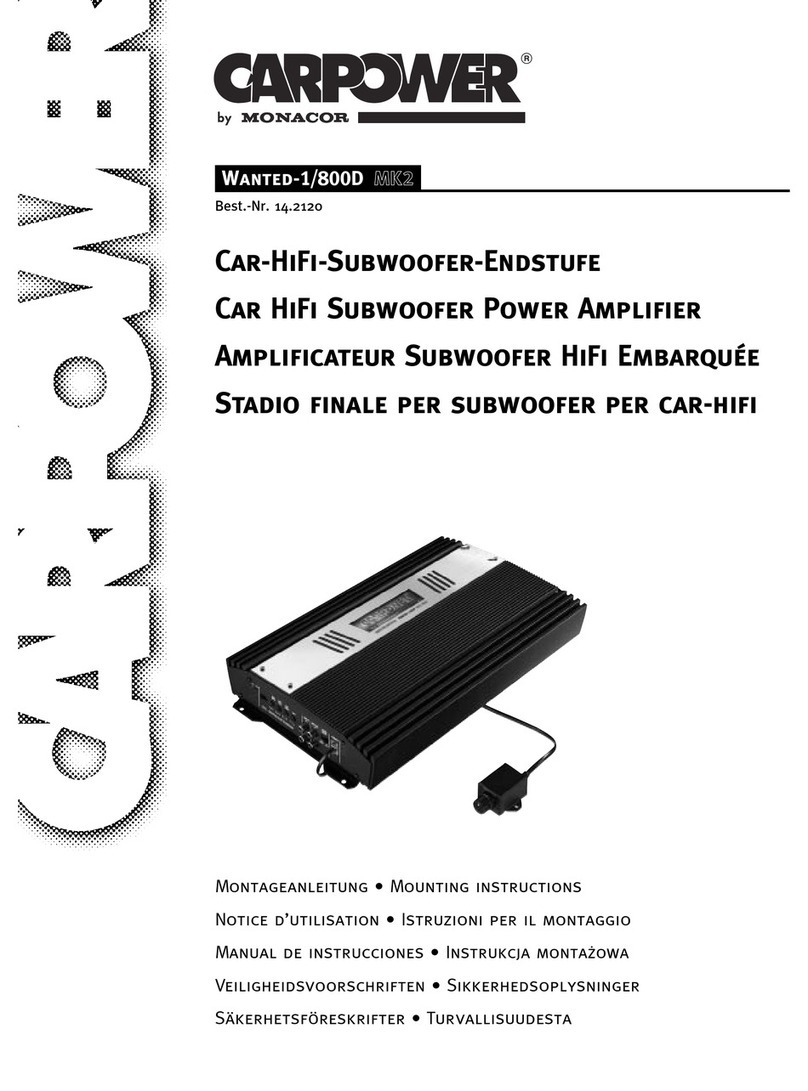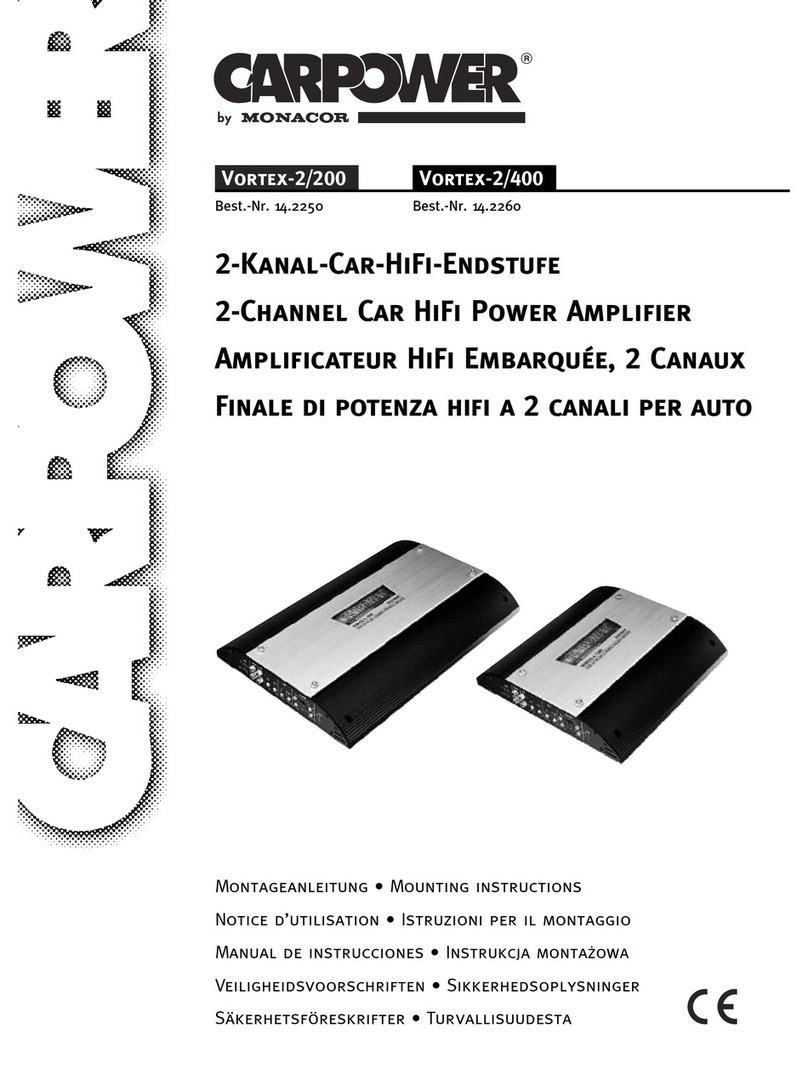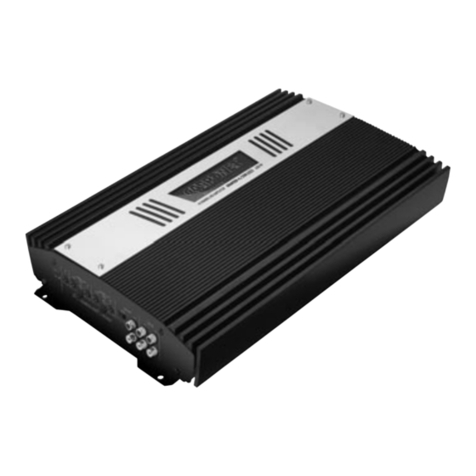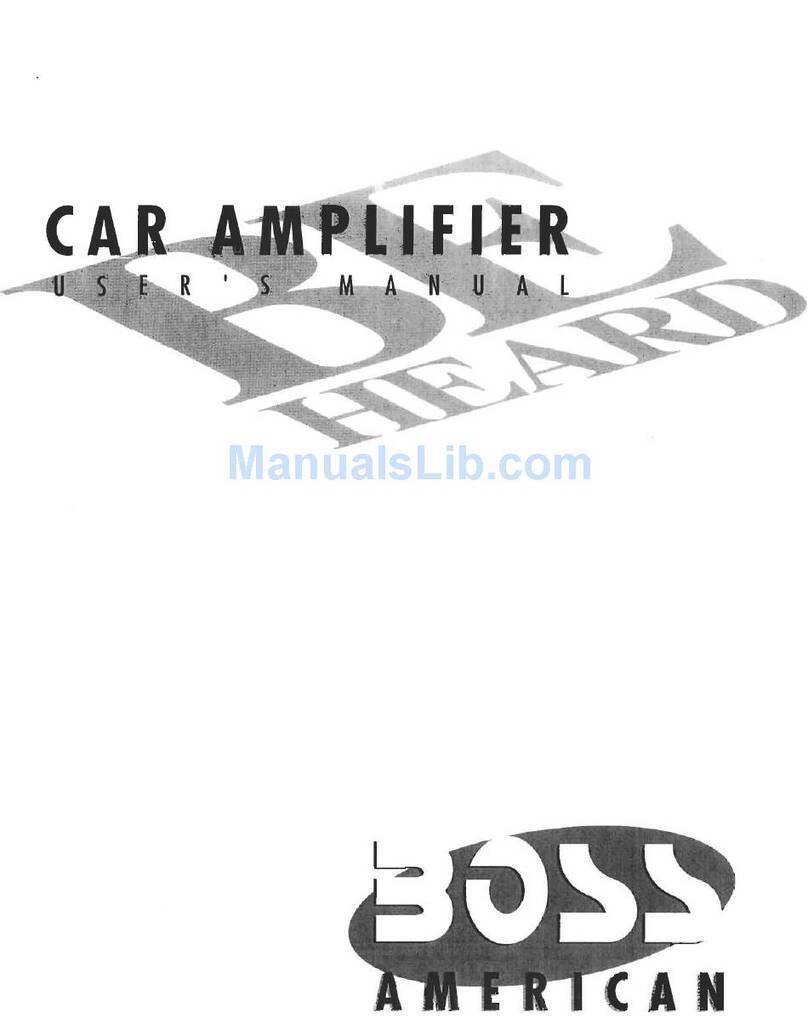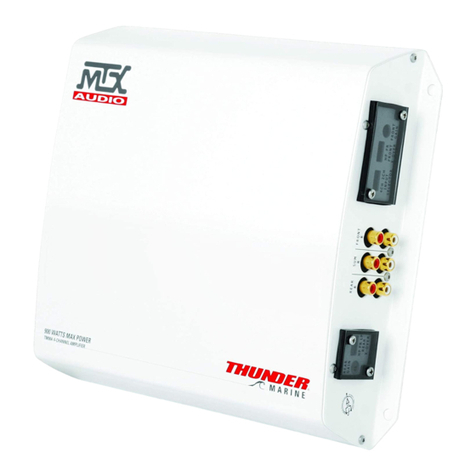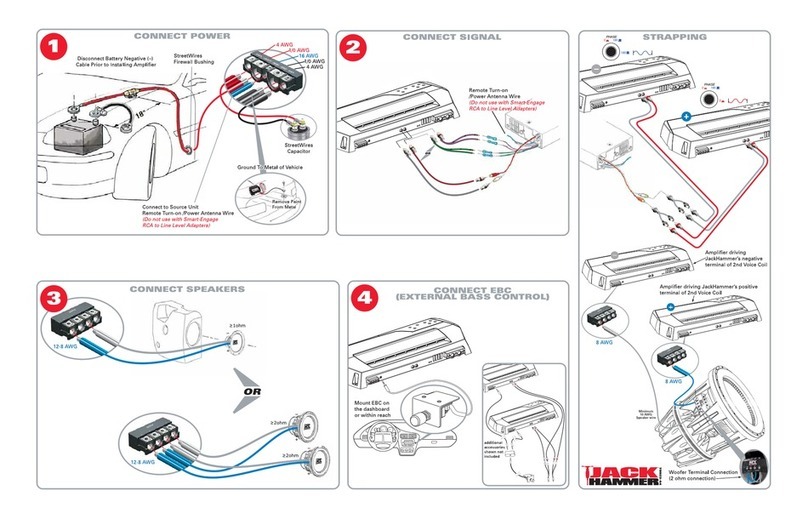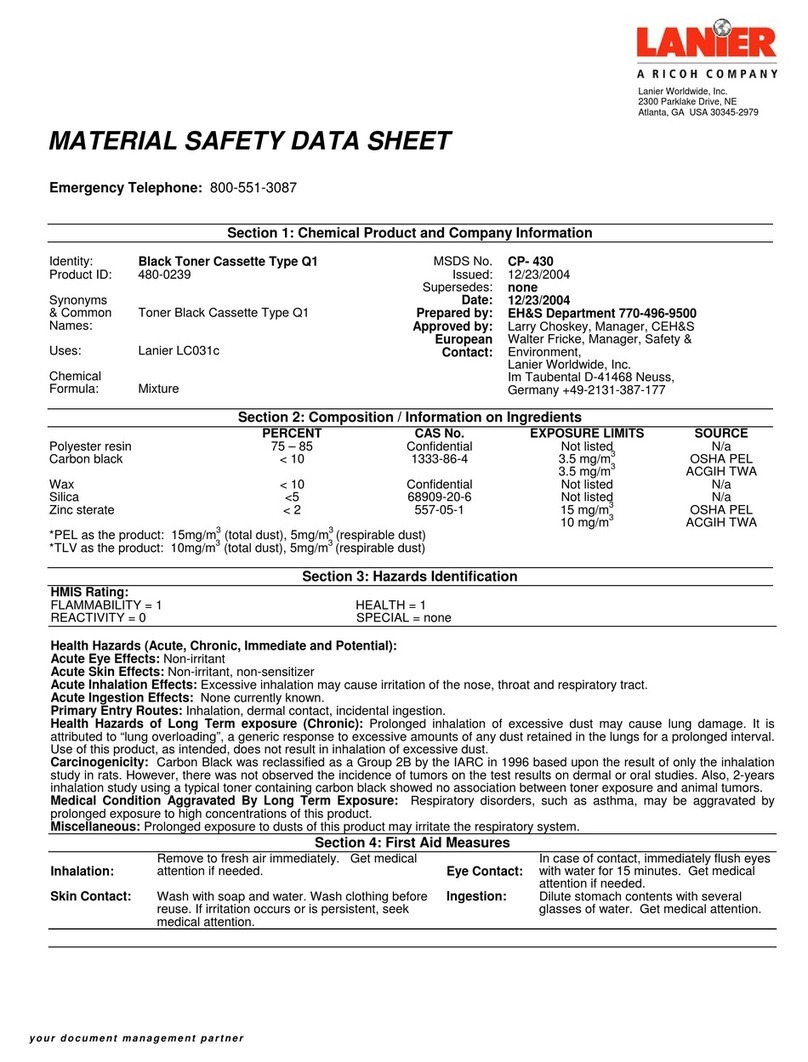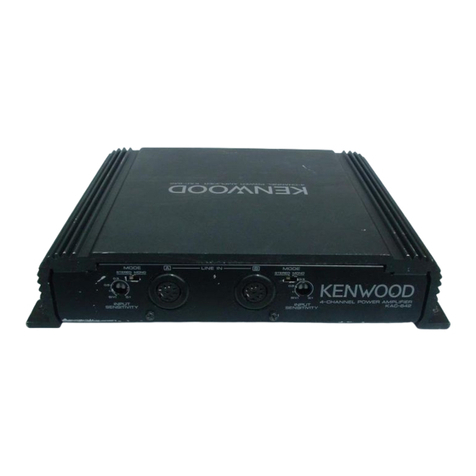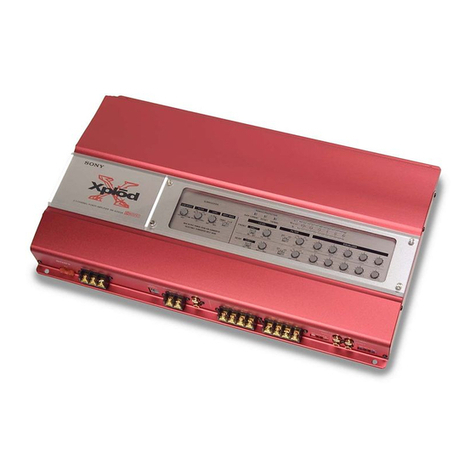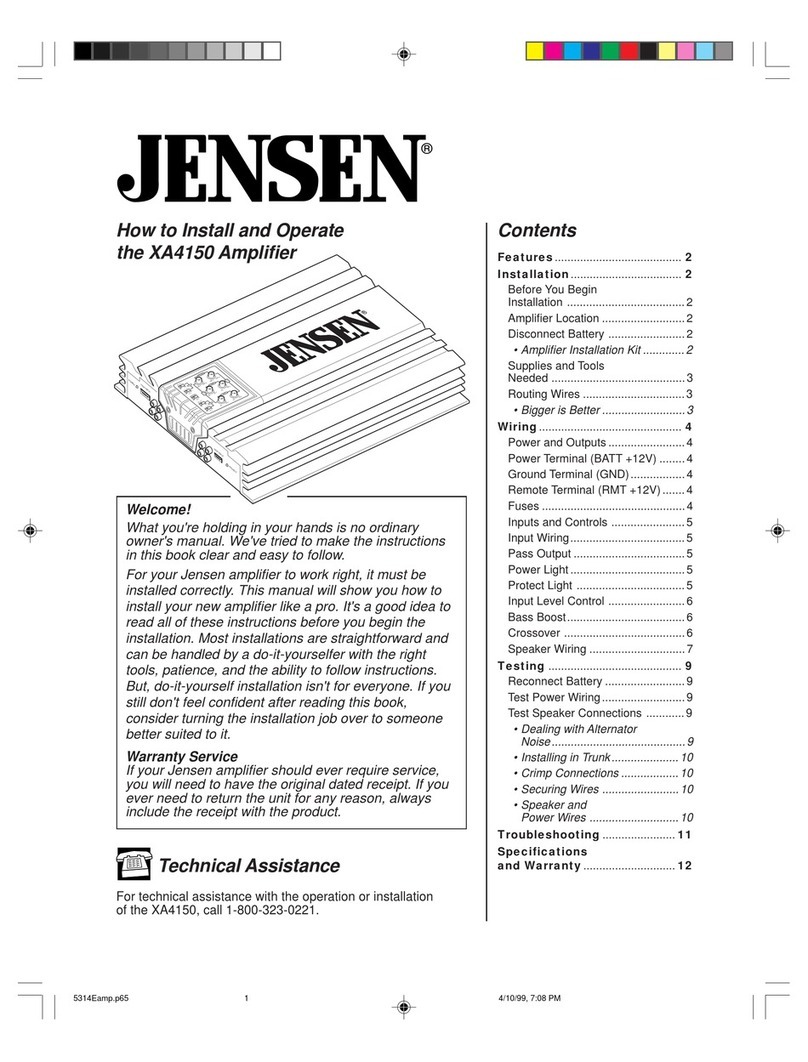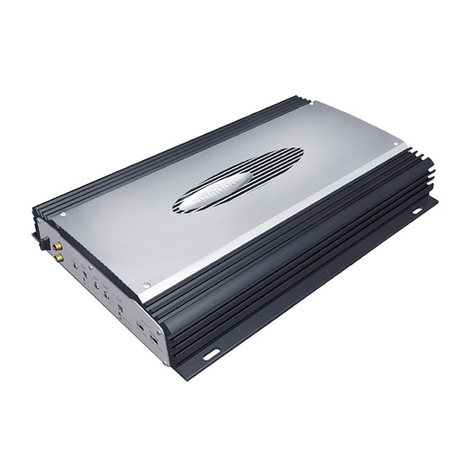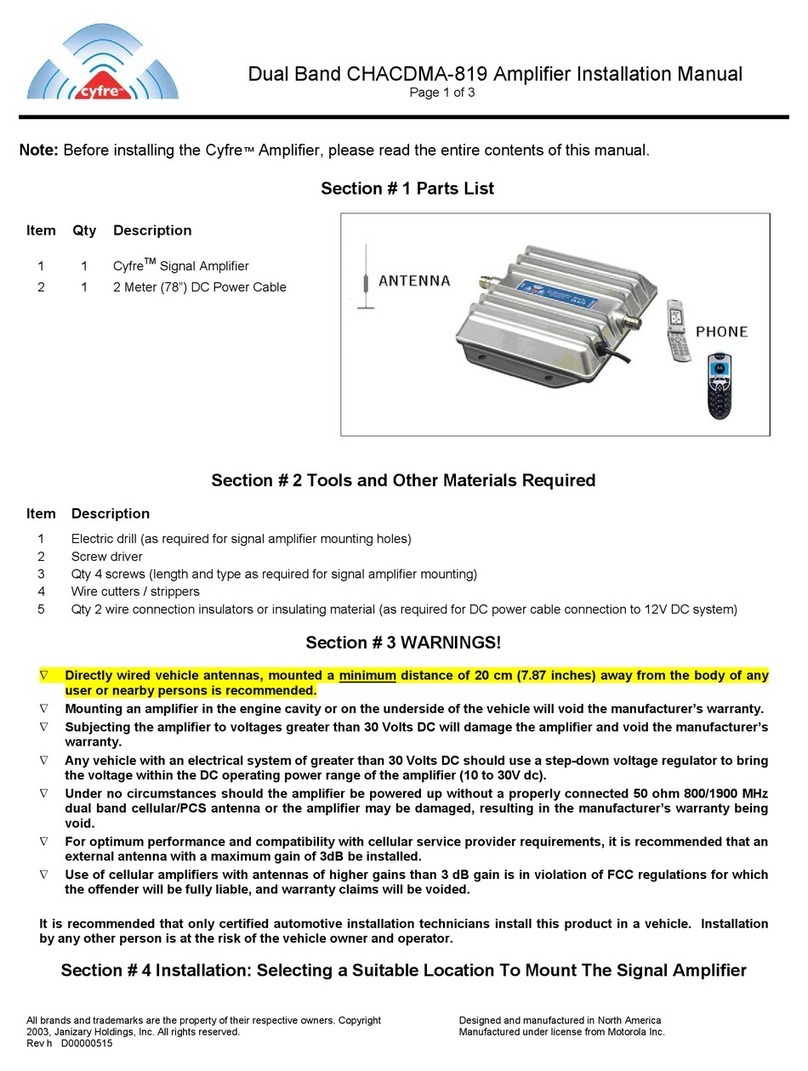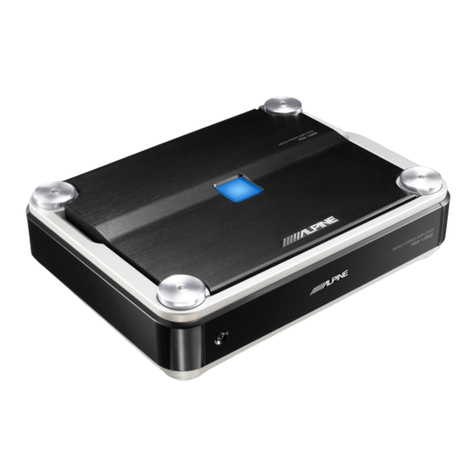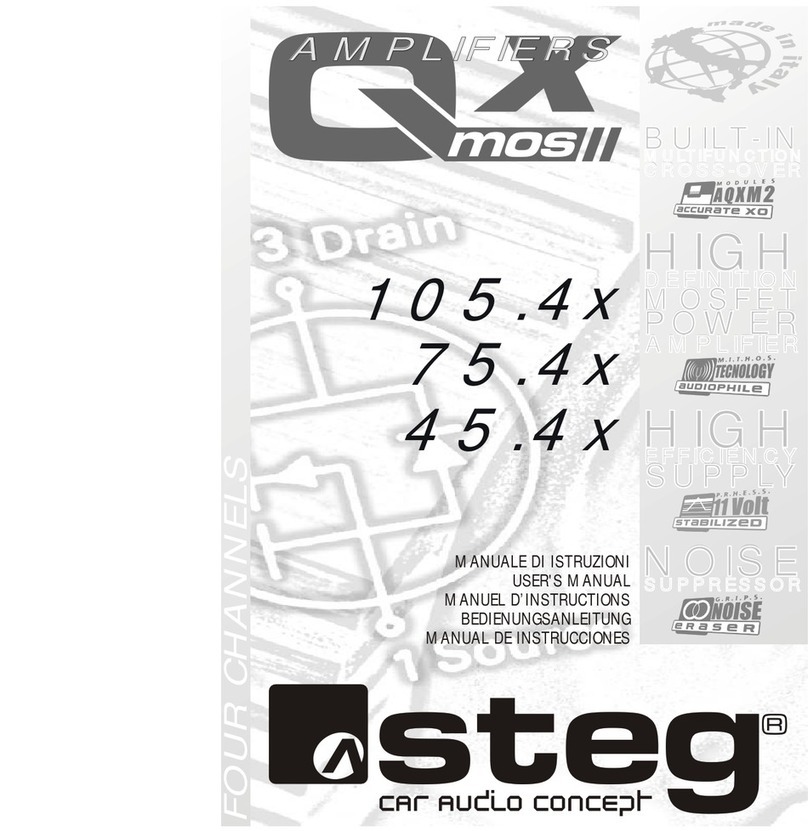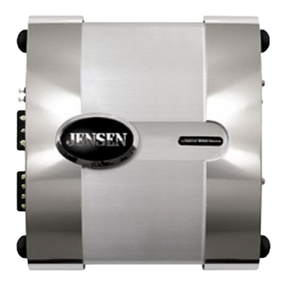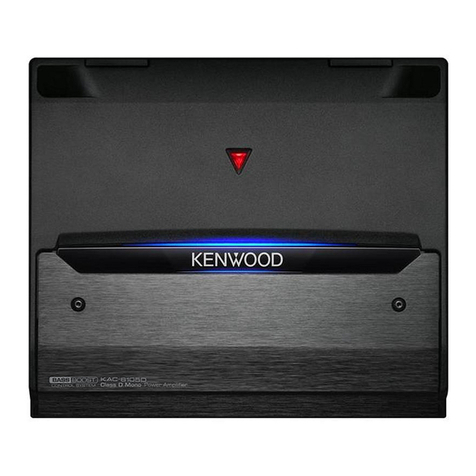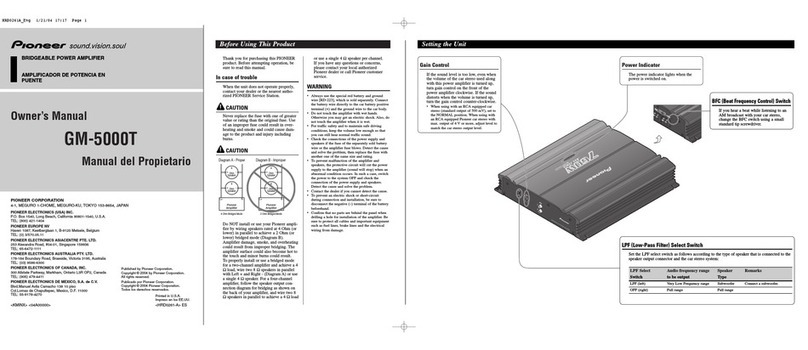CAP-…*). Reliez le condensateur aux bornes
EXTERNAL CAP (15). Veillez impérativement à res-
pecter la polarité du condensateur.
6.1.2 Branchement masse
Reliez la borne masse GND (16) via un cordon d’une
section minimale de 20 mm2(p. ex. CPC-200/SW*) à
la masse du véhicule ou encore mieux, directement à
la borne moins de la batterie de la voiture. Conseils :
1. Si vous utilisez la carrosserie comme branche-
ment masse, l’endroit utilisé doit avoir un bon
contact électrique avec la carrosserie principale
(p. ex. avec suffisamment de points de soudure).
Il faut enlever toute laque sur le point de contact.
2. Pour éviter tout bouclage de masse, la masse de
l’autoradio doit être placée à l’endroit où l’amplifi-
cateur est aussi à la masse.
6.1.3 Tension de commande pour allumer
L’amplificateur de Hi-Fi embarquée est allumé et
éteint par une tension de commande de +12 V à la
borne REM (17). Reliez la borne REM à la sortie de
commande 12 V de l’autoradio (branchement pour
une antenne motorisée, si nécessaire à brancher en
parallèle à l’antenne motorisée).
6.2 Entrée et sortie Ligne
1) Reliez les deux prises d’entrée INPUT (3) via les
cordons RCA aux sorties Ligne sur l’autoradio ou
si existantes aux sorties pour un amplificateur
subwoofer. Si l’autoradio n’est pas doté de sorties
ligne, les sorties haut-parleurs de l’autoradio peu-
vent être reliées aux entrées de l’amplificateur via
un transformateur adapté (p. ex. FGA-22HQ*).
2) L’entrée Ligne de l’amplificateur pour les haut-
parleurs principaux peut être reliée via un cordon
RCA aux prises LINE OUT (2). Le signal de sor-
tie à ces prises dépend de la position de l’inter-
rupteur FULL RANGE/HP > 80 Hz (1) :
FULL RANGE aucun filtre allumé
HP>80Hz le passe-haut pour les sorties
LINE OUT est allumé : les fréquen-
ces sous 80 Hz sont éliminées.
6.3 Haut-parleurs
Reliez le subwoofer (impédance minimale 2 Ω) aux
bornes SPEAKER + et
-
(21). Les deux paires de
connecteurs sont branchées en parallèle de sorte
que si besoin, deux subwoofers avec une impédance
de 4 Ωau moins peuvent également être connectés.
6.4 Mode bridgé
Avec un second D-REX/1202, la puissance de sor-
tie en mode bridgé peut être doublée à plus de 2 kW
sous 4 Ω. L’impédance du subwoofer ne doit pas, en
mode bridgé, être inférieure à 4 Ω. Le câblage pour
le mode bridgé est présenté sur le schéma 4. Les
connexions différentes du mode normal sont re-
pérées par un trait plus gras.
Pour la connexion des prises LINK (20) entre les
amplificateurs, un cordon adéquat est livré. Pour
relier la prise BRIDGE OUT (13) du premier amplifi-
cateur à la prise BRIDGE IN (13) du second amplifi-
cateur, utilisez un cordon audio blindé avec fiches
RCA mâles. Pour relier les pôles moins (
-
) des bor-
nes SPEAKER (21) entre les amplificateurs, utilisez
un câble haut-parleur.
6.5 Télécommande
Ala place d’un réglage fixe de niveau avec le
réglage GAIN (4), on peut utiliser la télécommande
(14) pour un réglage de niveau variable. On peut
ainsi augmenter ou diminuer les graves selon le
matériel de musique. Montez la télécommande à
portée du conducteur du véhicule. Placez le cordon
de branchement dans la prise REMOTE CONTROL
(12). Le réglage GAIN est ainsi hors fonction.
7Fonctionnement
1) Réglez la fréquence de coupure avec le réglage
LOWPASS (6) [c’est-à-dire la fréquence qui ne
doit plus être restituée par le subwoofer]. Le ré-
glage précis s’effectue après le réglage de ni-
veau avec les appareils de mesure correspon-
dants.
2) Avec le réglage SUBSONIC (5), réglez la fré-
quence de transmission inférieure du subwoofer.
Le subwoofer est protégé par le filtre subsonique
des très graves fréquences.
3) Tournez le réglage GAIN (4) entièrement à gau-
che sur la position “8 V” ou si la télécommande
(18) est reliée, tournez son réglage entièrement
vers la gauche vers la flèche “
-
”.
4) Allumez complètement l’installation Hi-Fi. L’am-
plificateur reste muet pendant 3 secondes envi-
ron (temporisation d’allumage) puis les deux
LEDs bleues sur la partie supérieure de l’appareil
s’allument.
5) Réglez la source audio, p. ex. l’autoradio, sur
le volume maximal ne présentant pas de distor-
sion.
Remarque : pour garder les interférences géné-
rées par l’installation électrique du
véhicule au niveau le plus bas, le
niveau de sortie de la source de
signal devrait être de 1,5 V mini-
mum.
!
Avant la première mise sous tension, vérifiez
l’ensemble du câblage de l’amplificateur,
reconnectez ensuite la borne moins de la bat-
terie.
Important : Lors de la sélection des haut-par-
leurs, veillez à prendre en compte la
capacité mécanique et électrique du
haut-parleur selon la puissance uti-
lisée de l’amplificateur. (Voir caractéri-
stiques techniques de l’amplificateur
page 11).
6.1.2 Collegamento della massa
Collegare in contatto della massa GND (16) con la
massa dell’auto o meglio direttamente con il polo
negativo della batteria, usando un cavo con sezione
minima di 20 mm2(p. es. CPC-200/SW*). N.B.:
1. Usando la carrozzeria come massa, il punto
usato deve presentare un buon contatto elettrico
con la carrozzeria principale (p. es. tramite un
numero sufficiente di punti di saldatura). La ver-
nice eventualmente presente deve essere tolta
completamente.
2. Per evitare l’effetto di anelli di terra, la massa
dell’autoradio deve essere collegata allo stesso
punto in cui è collegata la massa del finale.
6.1.3 Tensione di comando per l’accensione
Il finale di potenza hifi per auto si accende e si
spegne tramite una tensione di comando di +12 V al
contatto REM (17). Collegare il contatto REM con
l’uscita di commutazione di 12 V dell’autoradio (col-
legamento di un’antenna motorizzata; eventual-
mente collegare in parallelo con l’antenna).
6.2 Ingresso e uscita Line
1) Collegare le due prese d’ingresso INPUT (3) con
le uscite Line dell’autoradio oppure, se esistono,
con le uscite per un amplificatore per subwoofer,
usando cavi RCA. Se l’autoradio non possiede
nessun’uscita Line, le uscite per gli altoparlanti
possono essere collegate con gli ingressi del finale
per mezzo di un adattatore (p. es. FGA-22HQ*).
2) Collegare l’ingresso Line del finale per gli alto-
parlanti principali con le prese LINE OUT (2)
usando un cavo RCA. Il segnale d’uscita a que-
ste prese dipende dalla posizione dell’interruttore
FULL RANGE/HP > 80 Hz (1):
FULL RANGE nessun filtro attivato
HP > 80 Hz passa-alto per le uscite LINE
OUT attivato: le frequenze inferi-
ori a 80 Hz sono soppresse.
6.3 Altoparlanti
Collegare il subwoofer (impedenza minima 2 Ω) con
i contati SPEAKER + e
-
(21). Le due coppie di con-
tatti sono collegate in parallelo in modo che, se
necessario, si possono collegare anche due sub-
woofer con impedenza minima di 4 Ω.
6.4 Collegamento a ponte
Con un secondo D-REX/1202 collegato a ponte, la
potenza d’uscita può essere raddoppiata a oltre
2kW con 4 Ω. Nel funzionamento a ponte, l’impe-
denza del subwoofer non deve essere inferiore a
4Ω. Il cablaggio per il funzionamento a ponte è rap-
presentata in fig. 4. I collegamenti diversi dal funzio-
namento normale sono segnati con tratti più grossi.
Un cavo adatto per il collegamento delle prese
LINK (20) fra i finali si trova in dotazione. Per colle-
gare la presa BRIGDE OUT (13) del primo finale con
la presa BRIGDE IN (13) del secondo finale occorre
usare un cavo schermato con connettori RCA. Per
collegare i poli negativi (
-
) dei contatti SPEAKER
(21) fra i finali, usare un cavo per altoparlanti.
6.5 Telecomando
Al posto di una regolazione fissa del livello fatta con il
regolatore GAIN (4) è possibile usare il telecomando
(14) per una regolazione variabile del livello. In que-
sto modo è possibile alzare o abbassare i bassi a
seconda del tipo di musica. Montare il telecomando a
portata di mano del conducente. Inserire il cavo di
collegamento nella presa REMOTE CONTROL (12).
Il regolatore GAIN rimane ora senza funzione.
7Messa in funzione
1) Impostare la frequenza di taglio (cioè la fre-
quenza che non deve più essere riprodotta dal
subwoofer) con il regolatore LOWPASS (6). La
regolazione fine sarà fatta dopo l’impostazione
del livello con l’aiuto dei relativi strumenti di
misura.
2) Con il regolatore SUBSONIC (5) impostare la fre-
quenza inferiore di trasmissione del subwoofer. Il
filtro subsonico protegge il subwoofer dalla fre-
quenze molto basse.
3) Girare il regolatore GAIN (4) tutto a sinistra in
posizione “8 V” oppure, se è collegato il teleco-
mando (14) girare il suo regolatore tutto a sinistra
in direzione della freccia “
-
”.
4) Accendere completamente l’impianto hi-fi del-
l’auto. Il finale rimane muto per 3 secondi ca.
(ritardo dell’accensione), quindi si accendono i
due LED blu sul lato superiore dello strumento.
5) Regolare la sorgente, p. es. l’autoradio, sul volu-
me massimo senza che vi siano delle distorsioni.
Un consiglio: Per tener possibilmente bassi i
disturbi provocati dal sistema
elettrico della macchina, il livello
d’uscita della sorgente dovrebbe
essere non inferiore a 1,5 V.
6) Con il regolatore GAIN (4) o con il regolatore del
telecomando adattare il volume del subwoofer a
quello degli altoparlanti principali. Aprire il regola-
tore al punto da escludere appena l’accensione
della spia di sovrapilotaggio CLIP (8) con eventu-
ali distorsioni.
!
Prima della prima accensione, occorre verifi-
care l’esecuzione corretta dell’intero cablag-
gio del finale. Solo allora ricollegare il polo
negativo della batteria auto.
Importante! Nella scelta degli altoparlanti adatti
occorre fare assolutamente atten-
zione alla loro potenza meccanica e
elettrica in relazione alla potenza
usata del finale (vedi anche i dati tec-
nici del finale a pagina 11).
10
I
F
B
CH
*de CARPOWER
*di CARPOWER
